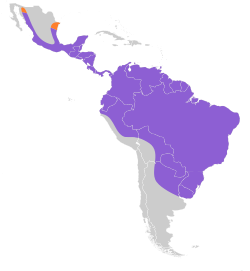| Tityridae | |
|---|---|
 | |
| Chestnut-crowned becard | |
| Scientific classification | |
| Kingdom: | Animalia |
| Phylum: | Chordata |
| Class: | Aves |
| Order: | Passeriformes |
| Parvorder: | Tyrannida |
| Family: | Tityridae Gray, GR, 1840 |
| Genera | |
See text | |
 | |
Tityridae is family of suboscine passerine birds found in forest and woodland in the Neotropics. The 45 species in this family were formerly spread over the families Tyrannidae, Pipridae and Cotingidae (see Taxonomy ). As yet, no widely accepted common name exists for the family, although tityras and allies and tityras, mourners and allies have been used. They are small to medium-sized birds. Under current classification, the family ranges in size from the buff-throated purpletuft, at 9.5 cm (3.7 in) and 10 grams (0.35 ounces), to the masked tityra, at up to 24 cm (9.5 in) and 88 grams (3.1 ounces). [1] [2] Most have relatively short tails and large heads.






